IoT-Based Electricity Bill for Domestic Applications
Abstract
1. Introduction
2. Statement of the Problem
2.1. Energy Tariffs
2.2. CFE Energy Bill
2.3. Bill Desingning
3. The IoT-Based Measurement System
3.1. Processing Module
3.2. Current and Voltage Sensors
3.3. Integrated System
3.4. Calibration
3.5. Forecast of Energy Consumption
4. The Proposed Interface
5. Experimental Results and Discussion
6. Conclusions
Author Contributions
Funding
Conflicts of Interest
References
- Siozios, K.; Anagnostos, D.; Soudris, D.; Kosmatopoulos, E. IoT for Smart Grids; Springer: Cham, Switzerland, 2019; pp. 1–282. ISBN 978-3-030-03169-5. [Google Scholar]
- Sælen, H.; Westskog, H. A Multi-Method Evaluation of the Potential for Using the Electricity Bill to Encourage Energy Savings in Norwegian Households. Energy Environ. Res. 2013, 3, 135. [Google Scholar] [CrossRef][Green Version]
- Xu, H.; König, L.; Cáliz, D.; Schmeck, H. A Generic User Interface for Energy Management in Smart Homes. Energy Inform. 2018, 1, 55. [Google Scholar] [CrossRef]
- Al-Hassan, E.; Shareef, H.; Islam, M.M.; Wahyudie, A.; Abdrabou, A.A. Improved Smart Power Socket for Monitoring and Controlling Electrical Home Appliances. IEEE Access 2018, 6, 49292–49305. [Google Scholar] [CrossRef]
- Ridi, A.; Gisler, C.; Hennebert, J. A Survey on Intrusive Load Monitoring for Appliance Recognition. In Proceedings of the 2014 22nd International Conference on Pattern Recognition, Stockholm, Sweden, 24–28 August 2014; pp. 3702–3707. [Google Scholar]
- Aladesanmi, E.J.; Folly, K.A. Overview of Non-Intrusive Load Monitoring and Identification Techniques. IFAC-PapersOnLine 2015, 48, 415–420. [Google Scholar] [CrossRef]
- Ve Venables, M. Smart Meters Make Smart Consumers. Eng. Technol. 2007, 2, 23. [Google Scholar] [CrossRef]
- Openenergymonitor Inc. Available online: https://shop.openenergymonitor.com/ (accessed on 31 August 2020).
- Malekian, R.; Bogatinoska, D.C.; Karadimce, A.; Ye, N.; Trengoska, J.; Nyako, W.A. A Novel Smart ECO Model for Energy Consumption Optimization. Elektronika ir Elektrotechnika 2015, 21, 75–80. [Google Scholar] [CrossRef]
- Ebeid, E.; Heick, R.; Jacobsen, R. Deducing Energy Consumer Behavior from Smart Meter Data. Future Internet 2017, 9, 29. [Google Scholar] [CrossRef]
- Buddhahai, B.; Wongseree, W.; Rakkwamsuk, P. An Energy Prediction Approach for a Nonintrusive Load Monitoring in Home Appliances. IEEE Trans. Consum. Electron. 2020, 66, 96–105. [Google Scholar] [CrossRef]
- Al-Ali, A.R.; Zualkernan, I.A.; Rashid, M.; Gupta, R.; Alikarar, M. A Smart Home Energy Management System Using IoT and Big Data Analytics Approach. IEEE Trans. Consum. Electron. 2017, 63, 426–434. [Google Scholar] [CrossRef]
- Chou, J.-S.; Truong, N.-S. Cloud Forecasting System for Monitoring and Alerting of Energy Use by Home Appliances. Appl. Energy 2019, 249, 166–177. [Google Scholar] [CrossRef]
- Srivatchan, N.S.; Rangarajan, P. A Novel Low-cost Smart Energy Meter Based on IoT for Developing Countries’ Micro Grids. Concurr. Comput. Pract. Exp. 2020, 32. [Google Scholar] [CrossRef]
- Mudaliar, M.D.; Sivakumar, N. IoT Based Real Time Energy Monitoring System Using Raspberry Pi. Internet Things 2020, 12, 100292. [Google Scholar] [CrossRef]
- Hargreaves, T.; Nye, M.; Burgess, J. Making Energy Visible: A Qualitative Field Study of How Householders Interact with Feedback from Smart Energy Monitors. Energy Policy 2010, 38, 6111–6119. [Google Scholar] [CrossRef]
- Costanza, E.; Ramchurn, S.D.; Jennings, N.R. Understanding Domestic Energy Consumption through Interactive Visualisation: A Field Study. In Proceedings of the 2012 ACM Conference on Ubiquitous Computing, Pittsburgh, PA, USA, 5–8 September 2012; pp. 216–225. [Google Scholar]
- Gram-Hanssen, K. Efficient Technologies or User Behaviour, Which Is the More Important When Reducing Households’ Energy Consumption? Energy Effic. 2013, 6, 447–457. [Google Scholar] [CrossRef]
- Pacific Gas and Electric Company. Available online: https://www.pge.com/en_US/residential/your-account/your-bill/understand-your-bill/understand-your-energy-statement/understand-your-energy-statement.page (accessed on 31 August 2020).
- British Gas Company. Available online: https://www.britishgas.co.uk/content/britishgas/youraccount/discover/your-bill/understanding-your-bill.html (accessed on 31 August 2020).
- What you Need to Know about you Electricity Bill. Available online: https://www.energyaustralia.com.au/sites/default/files/2018-11/Electricity.pdf (accessed on 31 August 2020).
- Erklärung zu Ihrer Jahresverbrauchsabrechnung. Available online: https://www.stw-frankenthal.de/service/musterrechnung.html (accessed on 31 August 2020).
- Taiwan Power Company e-Bill. Available online: https://ebpps2.taipower.com.tw/web-content/site-map-member/32 (accessed on 31 August 2020).
- Setup for Calculation of Electricity Charges. Available online: http://www.energia.co.jp/e/residential/calculation.html (accessed on 31 August 2020).
- Mon Explication de Facture. Available online: https://particulier.edf.fr/content/dam/2-Actifs/Documents/Explication%20facture/Facture_EDF_SIMM.pdf (accessed on 31 August 2020).
- Förklaring av Din Elfaktura. Available online: https://harrydaenergi.se/kundservice/faktura-och-betalsatt/fakturaforklaring/ (accessed on 31 August 2020).
- CFE. Available online: https://www.cfe.mx/Casa/InformacionCliente/Pages/Conoce-tu-recibo.aspx (accessed on 31 August 2020).
- Cámara de Diputados México. Available online: http://www3.diputados.gob.mx/camara/content/download/269327/825474/file/R.T.%20TARIFAS%2023.11.11.pdf (accessed on 31 August 2020).
- Particle Inc. Available online: https://store.particle.io/collections/wifi (accessed on 5 June 2020).
- YHDC. Available online: http://en.yhdc.com/product1311.html?productId=703 (accessed on 5 June 2020).
- Zeming-e. Available online: http://www.zeming.com/English/prodview.jsp?type=5&pid=298&key=zmpt101b (accessed on 5 June 2020).
- IEEE Power Energy Society. IEEE Standard Definitions for the Measurement of Electric Power Quantities Under Sinusoidal, Nonsinusoidal, Balanced, or Unbalanced Conditions; The Institute of Electrical and Electronics Engineers, Inc.: New York, NY, USA, 2010. [Google Scholar]
- Power Quality Meter Fluke 435 II. Available online: https://www.fluke.com/en-us/product/electrical-testing/power-quality/434-435 (accessed on 31 August 2020).
- The Free and Open-Source CDN. Available online: https://cdnjs.com/ (accessed on 1 September 2020).
- IoT Based Real Time Electricity Bill. Available online: https://sites.google.com/ucol.mx/iotbasedrealtimeelectricitybil/p%C3%A1gina-principal (accessed on 26 September 2020).
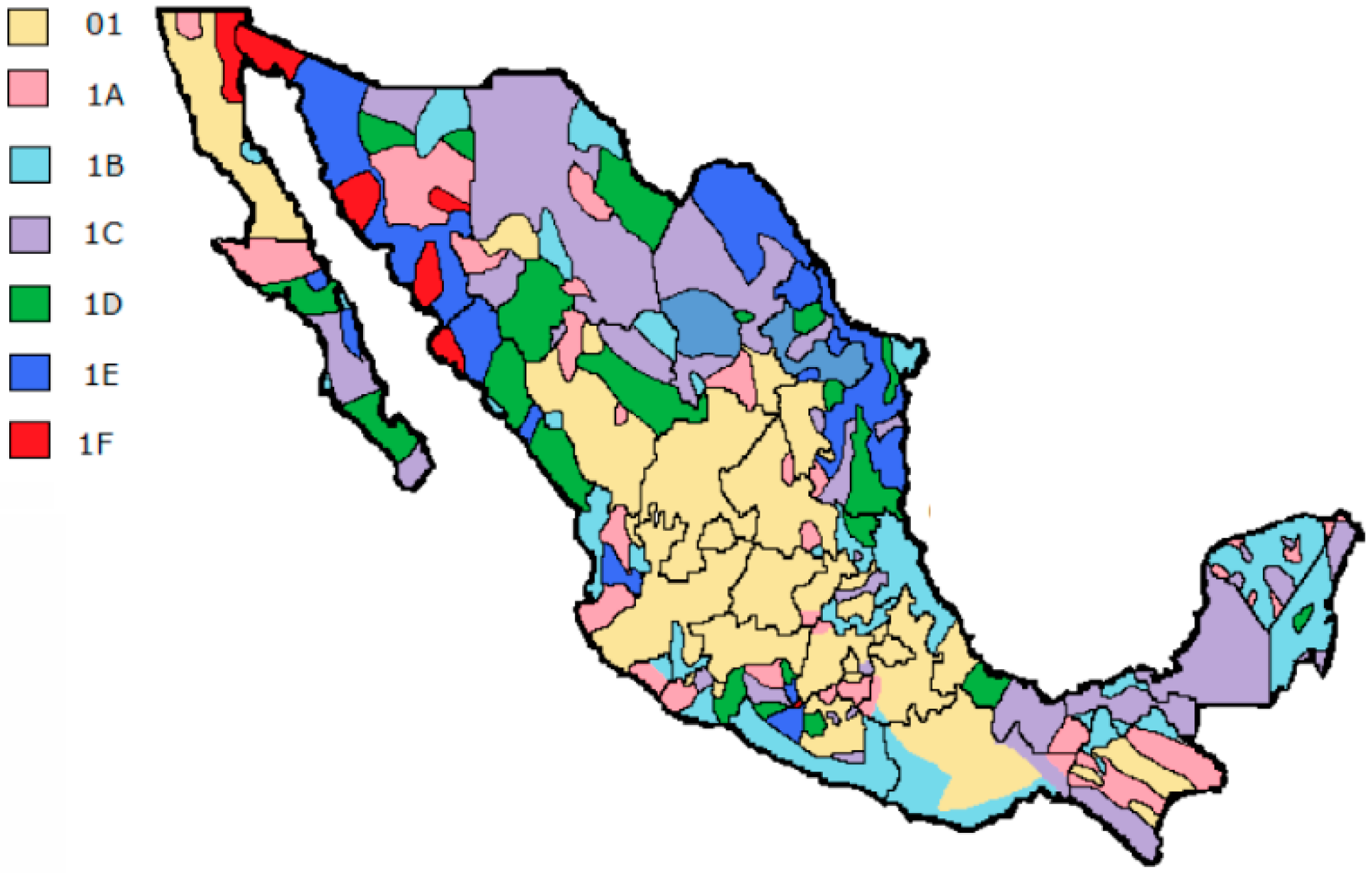

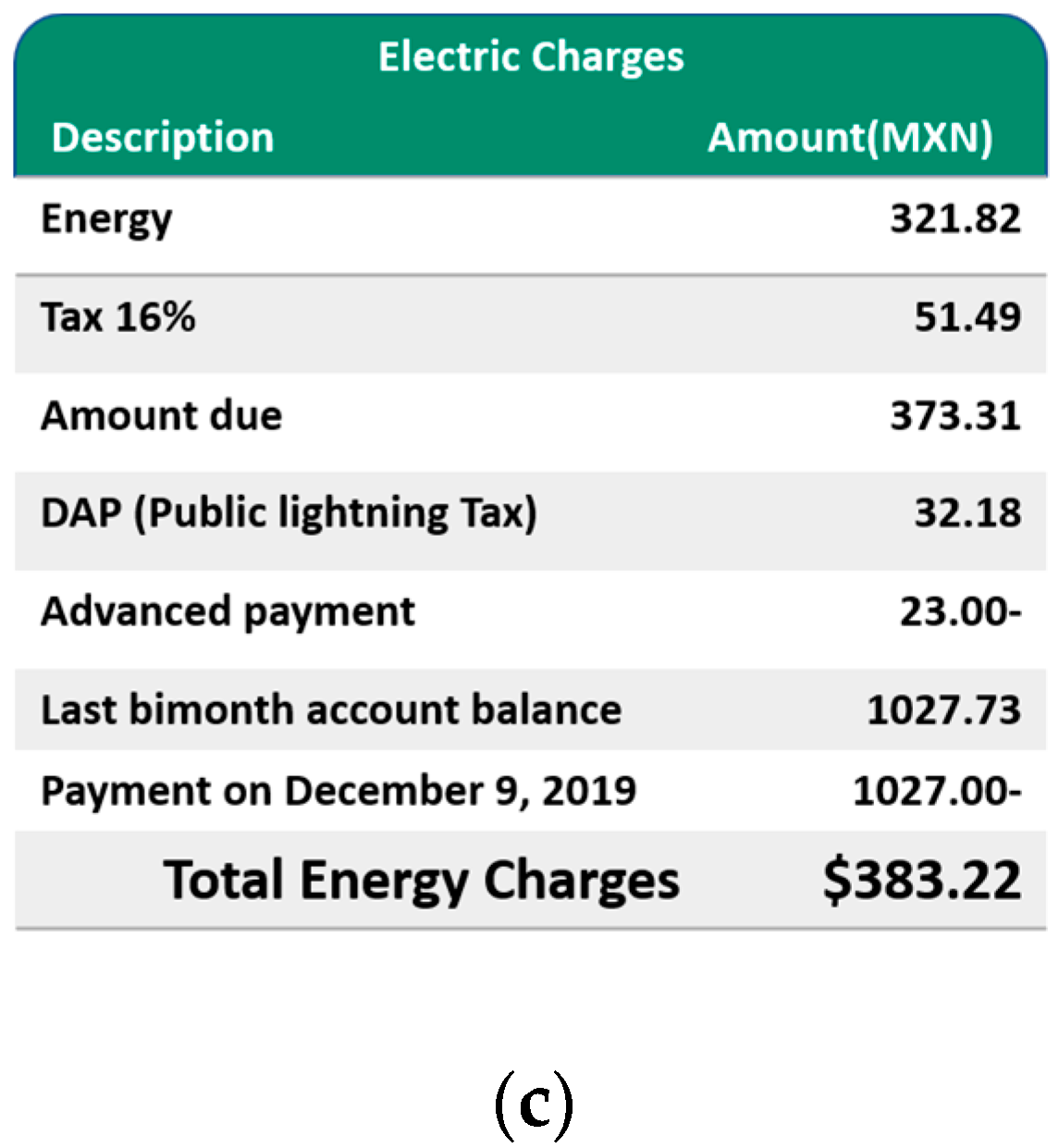

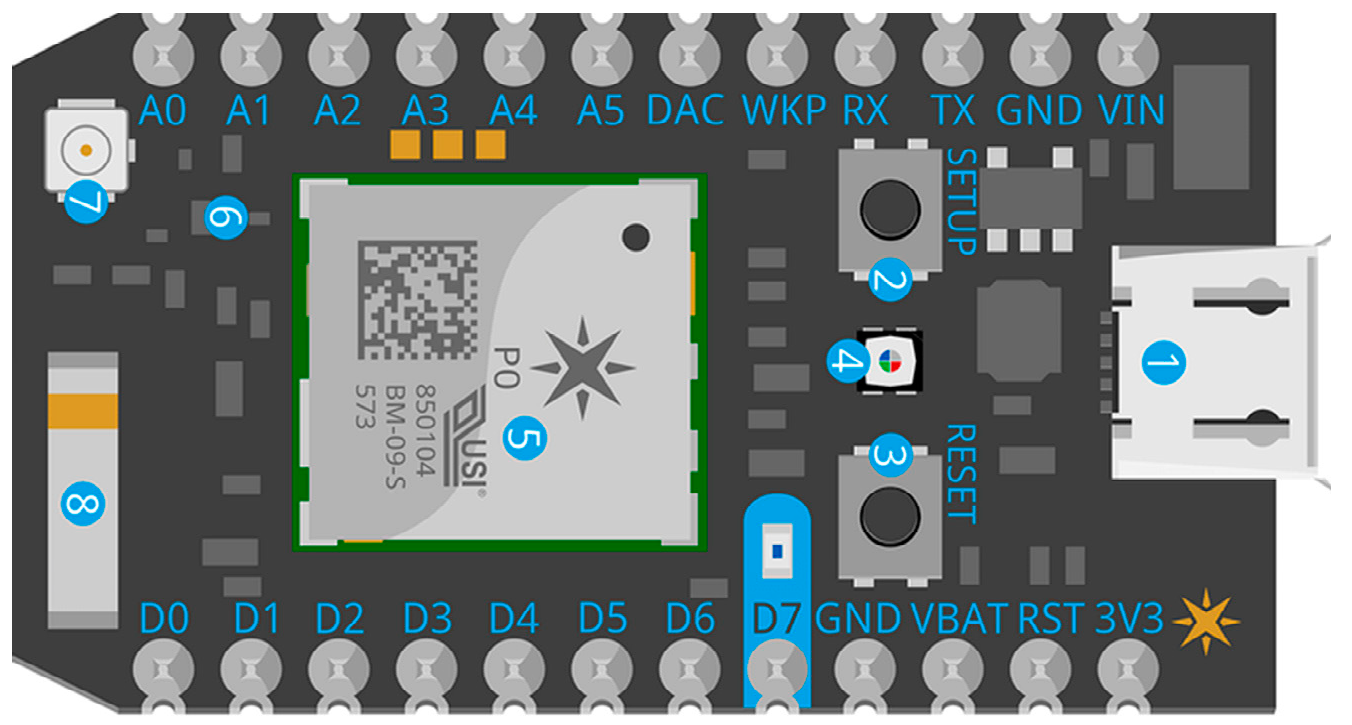


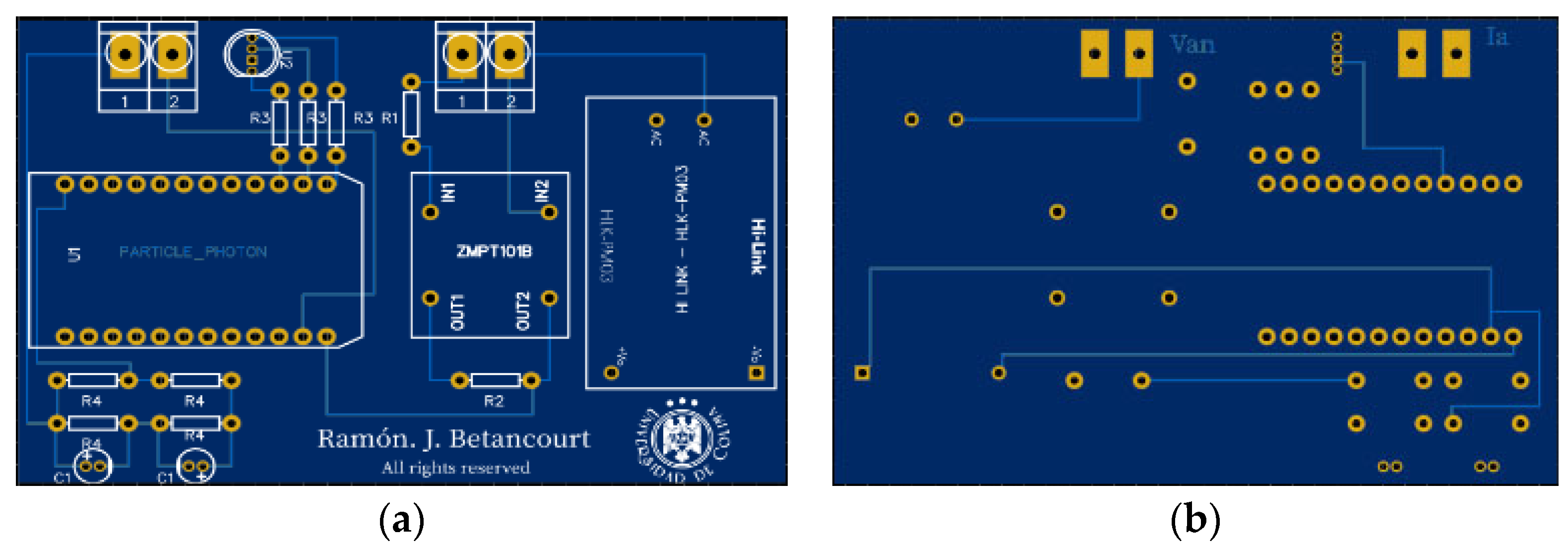
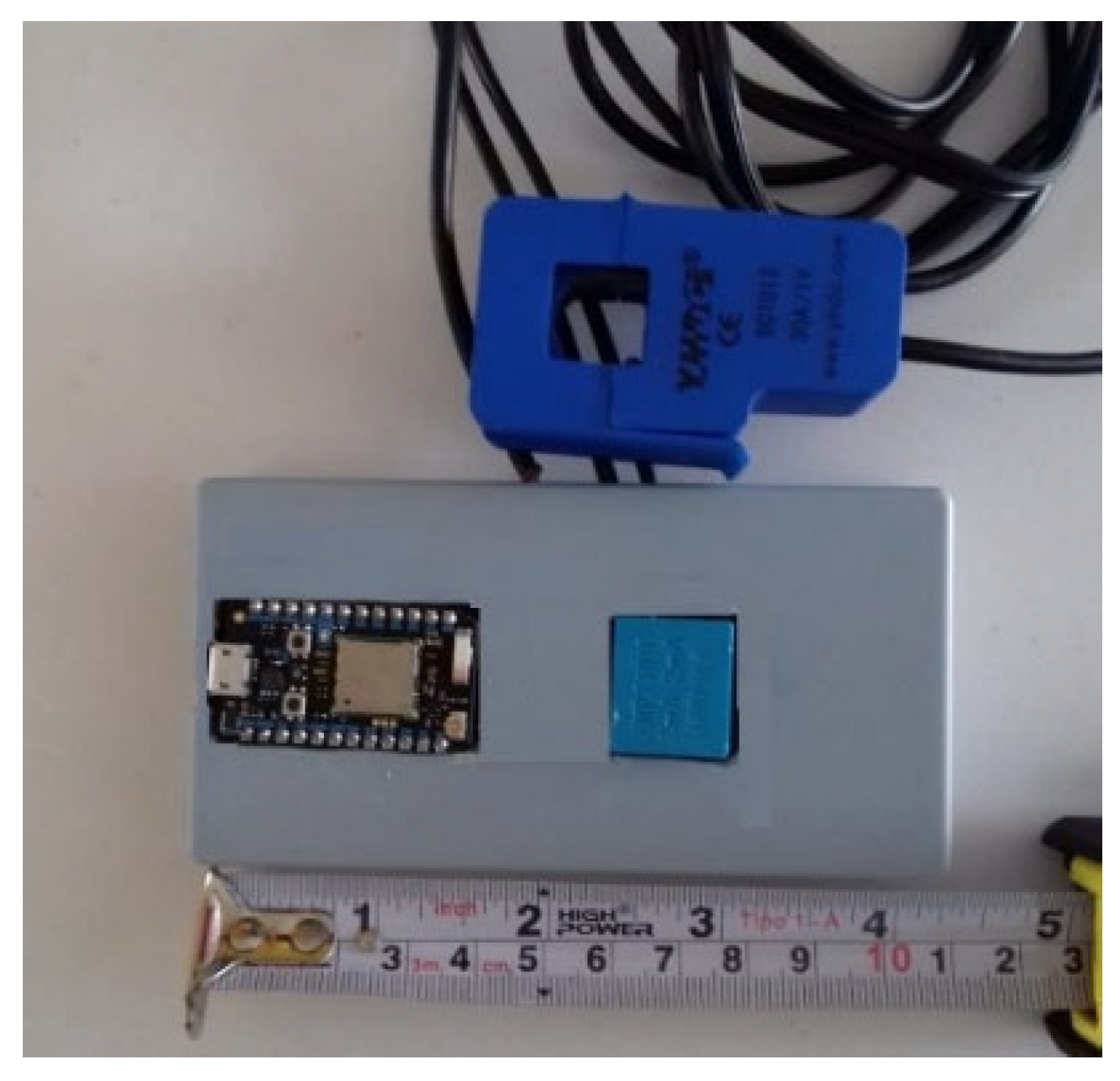

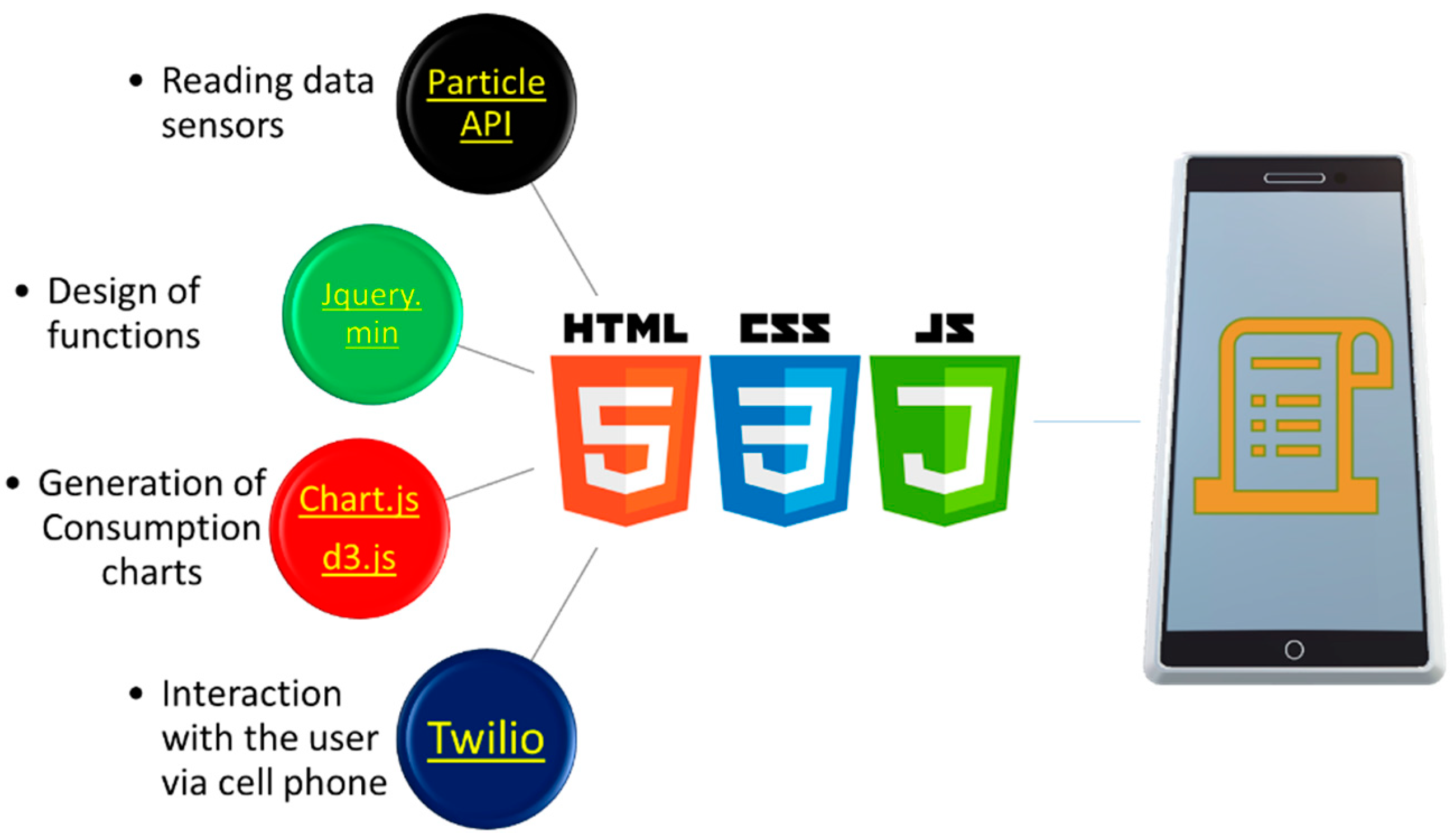
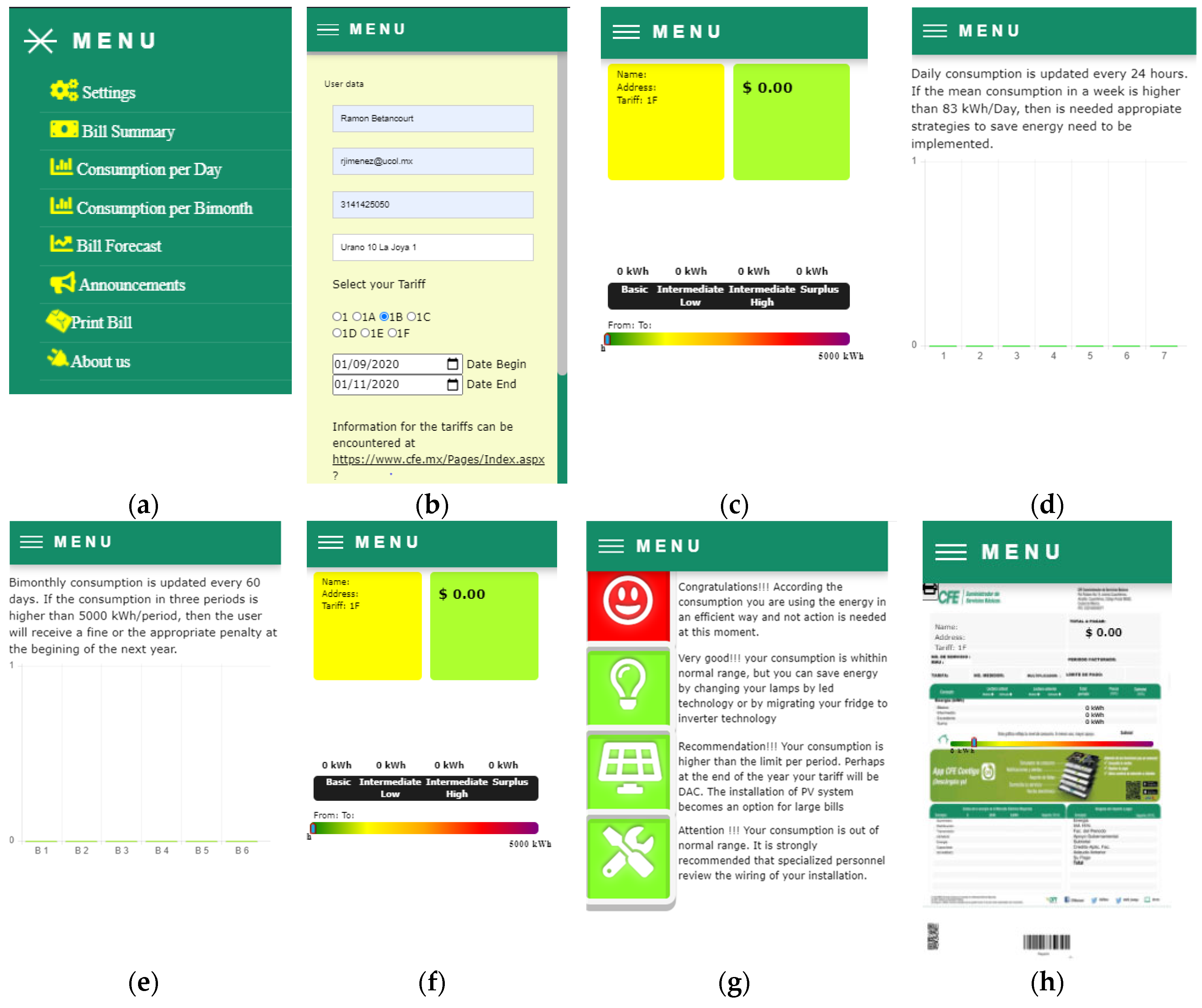
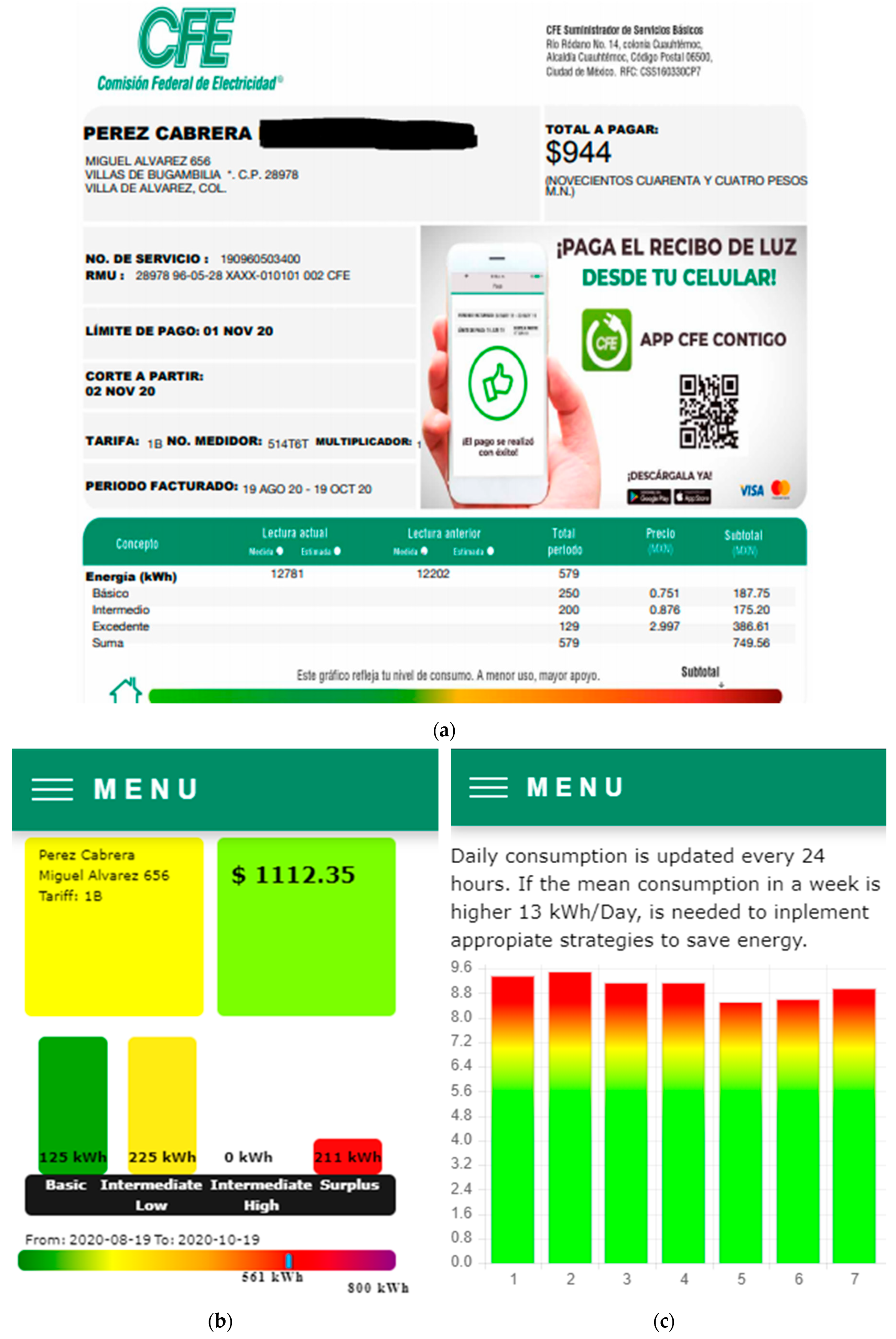

| Brand Name | Identify Appliances | Support for PV System | Approximated Price (USD) | Web Page |
|---|---|---|---|---|
| Sense Energy Monitor | ✓ | ✓ | $300.00 | https://sense.com/ |
| Neurio Home Energy Monitor | ✓ | ✘ | $45.00 | https://www.neur.io/ |
| Eyedro EHEM1 | ✘ | ✘ | $119.00 | http://eyedro.com/home-electricity-monitors/ |
| TED Pro Home Electricity Monitor | ✘ | ✓ | $299.95 | http://www.theenergydetective.com/tedprohome.html |
| Energy Engage Hub | ✘ | ✓ | $139.99 | https://engage.efergy.com/ |
| Tariff | Block | Max 5 | T °C | |||
|---|---|---|---|---|---|---|
| B 1 | IL 2 | IH 3 | S 4 | |||
| 1 | 0→75 | 75→140 | - | 140→ | 3000 | >25 |
| 1A | 0→100 | 100→150 | - | 150→ | 3600 | 25 |
| 1B | 0→125 | 125→225 | - | 225→ | 4800 | 28 |
| 1C | 0→150 | 150→300 | 300→450 | 450→ | 10,200 | 30 |
| 1D | 0→175 | 175→400 | 400→600 | 600→ | 12,000 | 31 |
| 1E | 0→300 | 300→750 | 750→900 | 900→ | 24,000 | 32 |
| 1F | 0→300 | 300→1200 | 1200→2500 | 2500→ | 30,000 | 33 |
| Screen | Objective |
|---|---|
| 1 | General data of the user, selection of tariff, begin and end of reading period. |
| 2 | Summary of consumption on real time. |
| 3 | Consumption for each day in a week. |
| 4 | Consumption for each period in a year. |
| 5 | Forecast of the consumption obtained with the mean of consumption. |
| 6 | Announcements when the consumption is within the moderate or excessive range. |
| 7 | Displaying real-time consumption on the company format. |
| Variable | Visualization Method | Alert Type | When |
|---|---|---|---|
| kWh in the period | Gradient color progress bar | SMS | It is higher than Max/6 or Max/12 |
| kWh Basic | Green progress bar | None | None |
| kWh Intermediate Low | Yellow progress bar | None | None |
| kWh Intermediate High | Orange progress bar | None | None |
| kWh Surplus | Red progress bar | SMS | It is reached before the middle the period |
| kWh accumulated over year | Numeric | SMS | It is near to the Max |
| Total and Pay due | Alphanumeric | SMS | five days before the deadline in each period |
| Daily consumption | Chart bar with gradient color | None | None |
| Bimonthly (monthly) consumption | Chart bar with gradient color | None | None |
| Diagnosis of consumption | Animated icon | None | None |
| IoTBEMS | |
|---|---|
| Maximum current | 30 A |
| Maximum voltage | 150 V |
| Number of additional current sensors that can be added | 5 |
| Number of digital channels | 8 |
| Open architecture | Yes |
| Device | Cost (USD) |
|---|---|
| Particle Photon | $20.00 |
| Sensor SCT-013 30A | $8.00 |
| Sensor ZMPT101B | $8.00 |
| PCB | $3.00 |
| Box container | $2.00 |
| Miscellaneous components | $5.00 |
| Total | $46.00 |
Publisher’s Note: MDPI stays neutral with regard to jurisdictional claims in published maps and institutional affiliations. |
© 2020 by the authors. Licensee MDPI, Basel, Switzerland. This article is an open access article distributed under the terms and conditions of the Creative Commons Attribution (CC BY) license (http://creativecommons.org/licenses/by/4.0/).
Share and Cite
Jiménez Betancourt, R.O.; González López, J.M.; Barocio Espejo, E.; Concha Sánchez, A.; Villalvazo Laureano, E.; Sandoval Pérez, S.; Contreras Aguilar, L. IoT-Based Electricity Bill for Domestic Applications. Sensors 2020, 20, 6178. https://doi.org/10.3390/s20216178
Jiménez Betancourt RO, González López JM, Barocio Espejo E, Concha Sánchez A, Villalvazo Laureano E, Sandoval Pérez S, Contreras Aguilar L. IoT-Based Electricity Bill for Domestic Applications. Sensors. 2020; 20(21):6178. https://doi.org/10.3390/s20216178
Chicago/Turabian StyleJiménez Betancourt, Ramón Octavio, Juan Miguel González López, Emilio Barocio Espejo, Antonio Concha Sánchez, Efraín Villalvazo Laureano, Sergio Sandoval Pérez, and Luis Contreras Aguilar. 2020. "IoT-Based Electricity Bill for Domestic Applications" Sensors 20, no. 21: 6178. https://doi.org/10.3390/s20216178
APA StyleJiménez Betancourt, R. O., González López, J. M., Barocio Espejo, E., Concha Sánchez, A., Villalvazo Laureano, E., Sandoval Pérez, S., & Contreras Aguilar, L. (2020). IoT-Based Electricity Bill for Domestic Applications. Sensors, 20(21), 6178. https://doi.org/10.3390/s20216178









